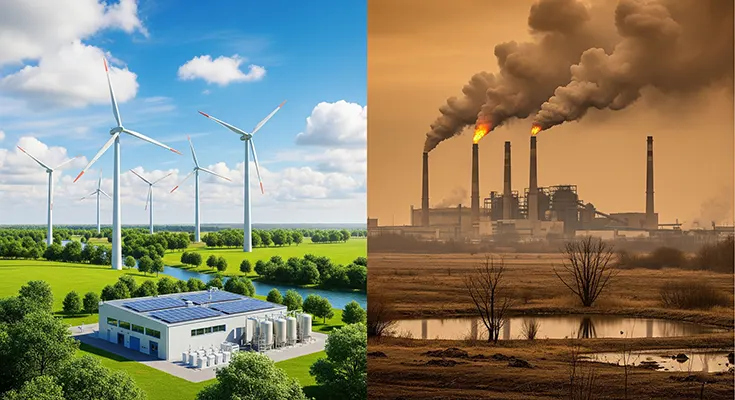Hydrogen fuel cell vehicles (FCEVs) are often lauded as the ultimate clean transportation solution, with their tailpipes emitting nothing but harmless water vapor. However, this “zero-emission” label is only half the story. The true environmental impact of a hydrogen car is not at the tailpipe, but at the point of production. The way hydrogen is produced—and the energy source used for that process—determines whether it is a truly clean fuel or a perpetuator of the very problems it seeks to solve.
The hydrogen industry has adopted a color-coding system to differentiate between various production methods and their associated environmental footprints. Understanding this system is crucial to evaluating hydrogen’s role in a sustainable future.
1. Gray Hydrogen: The Current Reality
The vast majority of hydrogen produced globally today is “gray” hydrogen. This is the most common and cheapest form, but it comes at a significant environmental cost.
- How it’s Made: Gray hydrogen is produced through a process called steam methane reforming (SMR). Natural gas (methane, CH4) is reacted with high-temperature steam, releasing hydrogen and creating carbon dioxide (CO2) as a byproduct.
- Environmental Impact: The CO2 generated from this process is typically vented directly into the atmosphere, contributing to greenhouse gas emissions and climate change. For every kilogram of hydrogen produced, the process can release up to 10 kilograms of CO2. This means that a vehicle powered by gray hydrogen, while having no tailpipe emissions, is still indirectly contributing to global warming.
2. Blue Hydrogen: A Transitional Solution?
“Blue” hydrogen is an attempt to mitigate the environmental impact of gray hydrogen.
- How it’s Made: Like gray hydrogen, blue hydrogen is produced from natural gas using SMR. However, it incorporates Carbon Capture, Utilization, and Storage (CCUS) technology. The CO2 that is a byproduct of the process is captured, compressed, and then stored underground in geological formations or used for other industrial purposes.
- Environmental Impact: Blue hydrogen is a step towards decarbonization, as it significantly reduces the amount of CO2 released into the atmosphere. However, it is not a perfect solution. CCUS technology is not 100% efficient, and some emissions can still escape. Furthermore, methane, the primary input, is a potent greenhouse gas, and any leaks during its extraction and transport can undermine the environmental benefits. The long-term safety and stability of underground CO2 storage also remain areas of concern.
3. Green Hydrogen: The Sustainable Ideal
“Green” hydrogen is the only form of hydrogen that is truly a zero-emission fuel from a “well-to-wheel” perspective.
- How it’s Made: Green hydrogen is produced through a process called electrolysis. An electric current is passed through water (H2O), splitting it into its constituent parts: hydrogen (H2) and oxygen (O2). The key to this process being “green” is that the electricity used must be sourced from renewable energy, such as solar, wind, or hydropower.
- Environmental Impact: When produced with 100% renewable energy, green hydrogen has virtually no greenhouse gas emissions. The only byproducts are water and oxygen, making it a completely clean process. It represents the ultimate goal for the hydrogen economy, as it aligns perfectly with global decarbonization efforts.
The Challenge and the Path Forward
The central environmental dilemma for hydrogen-powered vehicles is that while the end product is clean, the production methods currently in use are not. The widespread adoption of FCEVs would, with today’s technology, increase the demand for gray hydrogen, potentially leading to more greenhouse gas emissions.
The transition to a truly clean hydrogen economy hinges on several critical factors:
- Scaling Up Green Hydrogen: The biggest challenge for green hydrogen is cost and scale. Electrolysis is currently more expensive and energy-intensive than SMR. Significant investments in renewable energy and electrolyzer technology are needed to bring costs down and increase production capacity.
- Policy and Incentives: Governments and international bodies are playing a crucial role by providing funding and incentives for the development of green hydrogen projects and the necessary infrastructure.
- Addressing the “Chicken and Egg” Problem: While the FCEV market is small, there is little incentive to build a large-scale green hydrogen production and distribution network. This creates a circular problem that requires concerted effort and strategic investment to overcome.
While hydrogen fuel cell vehicles offer a compelling vision of a zero-emission future, their environmental performance is entirely dependent on the source of their fuel. The promise of hydrogen will only be fully realized when the world moves beyond gray and blue hydrogen and embraces a future powered by the truly clean, renewable energy of green hydrogen.

